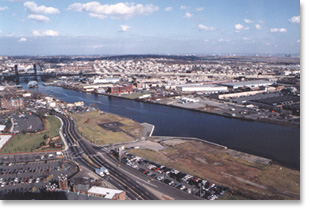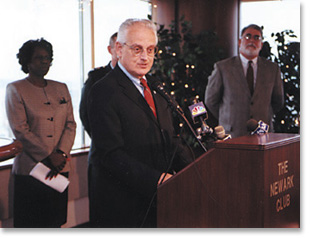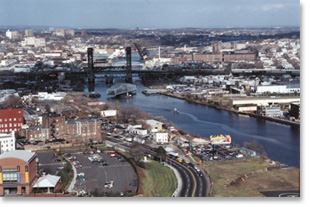Cry Me a River
The Passaic River Restoration provides a nationwide model for addressing polluted urban rivers
By Jonathan P. Deason, Ph.D., P.E.
Many urban rivers across the nation suffer from high levels of pollution from industrial effluents, municipal waste discharges, urban runoff and other sources. While pollution sources in some cases have been reduced, severely contaminated sediments in many rivers may still adversely affect aquatic life and limit recreational and economic uses of the rivers.
The magnitude of the contaminated sediment problem in the U.S. is striking. In its 1997 report, The Incidence and Severity of Sediment Contamination in Surface Waters of the United States, the EPA estimated that more than 1.2 billion cubic yards of contaminated sediment exist nationwide. These contaminated sediments are said to exact a potentially significant toll on human and ecological health across the nation. Threats cited in EPA's 1998 Contaminated Sediment Management Strategy include possible juvenile neurological and IQ impairment from food chain poisoning, increased incidence of cancer and long-term damage to aquatic ecosystems.
Solutions of the past
Past attempts to address the problem of contaminated sediments in urban rivers through the Superfund program have not been met with much success. This is due to the fact that the Superfund program, which was designed for land-based contaminated sites, does not fit well with aquatic environments. Typically, in aquatic environments, contaminated sediment problems cover large geographical areas, involve many chemicals and a large number of dischargers (sometimes thousands and, when municipalities are included, millions), and often reflect a long history of contamination (often exceeding a century).
The Superfund program, on the other hand, is best applied to relatively small, well-defined areas with clear relationships between the presence of contaminants and the generators and transporters who put them there. The strict, joint, several and retroactive liability provisions of Superfund, when applied to contaminated sediment problems, typically lead to a long-term litigious morass in which huge amounts of money are wasted in so-called "transaction costs," rather than that money being applied to actual cleanup.
When one superimposes on this situation, the inability of Superfund to deal with problems of ongoing pollution, huge numbers of stakeholders and other complexities common to urban river corridors, it is not hard to see why a new paradigm is needed.
A new approach
In response to this situation, a new cooperative program to restore rivers affected by contaminated sediments is being considered by the U.S. Congress. This new approach, titled the Urban River Restoration Initiative, envisions a new urban industrial river restoration initiative for the U.S. Army Corps of Engineers, working in conjunction with the EPA and other appropriate federal, state and local agencies.
Under this urban river restoration concept, the Corps would conduct cooperative project planning and development processes, in conjunction with state and local agencies and other stakeholders, to identify and apply the most feasible technical solutions to achieve environmental restoration and economic revitalization in degraded river corridors. Feasible restoration projects would require project-specific authorization before implementation.

The new initiative has strong synergy with several current major federal initiatives, including EPA's Total Maximum Daily Load initiative and the brownfields redevelopment initiative. A recent Corps of Engineers-sponsored study of 262 brownfields redevelopment case studies, for example, found that the solution to urban river corridor water quality degradation problems is a key ingredient at 37 (14.1 percent) of the sites. When viewed in light of the 425,000 brownfield sites said to exist by the General Accounting Office, the potential contribution that a solution to the contaminated sediment problem can make to the national brownfields redevelopment initiative is obvious.
While the Urban River Restoration Initiative holds promise for urban river corridors throughout the United States, the lower Passaic River in New Jersey has been identified as a pilot project area for the initiative. The lower Passaic is located in the heart of the U.S. industrial revolution that began in the late 19th century.
Since the beginning of the industrial revolution, hundreds of chemical, paint and pigment manufacturing plants, petroleum refineries, and other large industrial facilities have discharged effluents into the Passaic. While many of these facilities have closed, 13 petroleum refineries and six chemical manufacturing plants are still operating. High concentrations of dioxins, mercury, lead, polychlorinated biphenyls (PCBs) and other chemicals characterize this highly degraded river system. The river has also been heavily impacted by massive urbanization and population growth in the region.
More than a century of urbanization and heavy industrial use of the Passaic River Basin have resulted in extensive shoreline impacts, including an almost complete loss of tidal and freshwater wetland habitat through bulkheading and other anthropogenic structural changes. Impacts to fish and shellfish have been extensive, as have impacts to birds and mammal populations. In addition, a number of historical tributaries to the Passaic have been converted to storm sewer drains or filled in, and normal freshwater inflows have been replaced largely by contaminated urban run-off. Human uses such as fishing, rowing, boating, swimming, picnicking and wildlife observation have also been severely degraded. Other dimensions of complexity include pathogenic microbial contamination, seasonal anoxic conditions, floatable debris, excessive levels of waterborne nutrients and non-point source discharges.
A large number of stakeholder groups have interests in the Passaic watershed, including municipalities, environmental organizations, industries and other entities. Considerations of environmental justice also are important in the Passaic Basin, where minorities and economically disadvantaged people may be exposed disproportionately to these degraded conditions.
Need for a watershed-based approach

The complex nature of the Passaic River problems, similar to other urban rivers, makes a comprehensive watershed approach essential to successful economic revitalization and environmental restoration. The term "watershed approach" refers to an integrated perspective in water resources planning that provides a framework for integrating economic, natural and social considerations that share the same geographic space. This framework facilitates coordination of public and private sector efforts to address the highest priority problems within hydrologically defined geographic areas such as the Passaic River Basin.
Important elements of the watershed approach include assessment of natural, social and economic resources, interdisciplinary identification of priority problems, identification of goals and objectives, facilitation of high levels of stakeholder involvement, development of integrated solutions that make use of the expertise of multiple agencies, utilization of management techniques based on sound science, and measurement of success through monitoring and other types of data collection.
Under the watershed approach, appropriate agencies compare lists of high priority areas, meet with each other and other stakeholders, and look for opportunities to leverage finite resources to meet common goals.
It is precisely this type of challenge that the Corps of Engineers, with its extensive experience in comprehensive watershed planning and multidisciplinary capabilities, is well suited to address. Under recently enacted legislative authorities, the Corps now has authority to undertake single-purpose ecosystem restoration initiatives, or multiple purpose projects that include ecosystem restoration as a purpose.
These authorities enable the Corps to undertake all aspects of ecosystem protection and restoration studies and project implementation. Such broad statutory authorities, combined with the Corps' state-of-the-art expertise with recently developed analytical tools relevant to watershed-based planning (such as GIS, GPS, powerful electronic computational hardware and software, and the Internet), make conversion of the theoretical watershed approach into specific project and programmatic activities a realistic expectation.
In order to facilitate the new roles envisioned in these new authorities, the Corps last year established a new planning objective for its Civil Works planning studies--the National Ecosystem Restoration (NER) objective. Under new Corps guidance, single purpose ecosystem restoration plans may be formulated and evaluated in terms of their contributions to increases in ecosystem values.
The Passaic River Environmental Restoration Study
Last year, the first steps to activate the Urban River Restoration Initiative on the lower Passaic River were undertaken. In a resolution dated April 11, 2000, the Transportation and Infrastructure Committee of the U.S. House of Representatives authorized the Corps of Engineers to conduct a reconnaissance-level investigation titled the Passaic River Environmental Restoration Study. Initial funding for the effort was provided in the fiscal year 2001 Energy and Water Development Appropriations bill, signed into law by President Clinton on October 27, 2000.
While the precise geographic area of the study has not yet been defined by the Corps, it may include the lower 23 miles of the Passaic River from Dundee Dam to Newark Bay, as well as part of Newark Bay and wetlands adjacent to some reaches of the Hackensack River. Specific actions to be undertaken will be developed by the Corps through its cooperative planning process.
Why does the Lower Passaic River represent a good pilot area for testing the Urban River Restoration Initiative? There are several reasons. For one, the complexity of the situation, as described above, demands a comprehensive, watershed-based approach to the problem. Site-specific solutions undertaken in the absence of an overall regional solution are doomed to failure no matter how well they may be designed and funded. Application of the Corps' experience and expertise in comprehensive watershed planning not only represents a promising solution to the problems of the Passaic, but also should provide an excellent real-world test of this new approach.
Although the complexity of the situation may appear intimidating, a great deal of information collection and stakeholder team building already has occurred in the Basin. Considerable work in the Passaic Basin, for example, has been performed by the New York-New Jersey Harbor Estuary Program. The Corps of Engineers itself recently reviewed the lower Passaic as part of its related Hudson-Raritan Estuary Environmental Restoration Study. In addition, private companies located in the basin have invested over $27 million in relevant research studies on the River in recent years, providing a strong analytical foundation for identifying and evaluating restoration options.
In addition to these reasons, the Passaic River Environmental Restoration Study offers considerable synergy with other related efforts, such as the Urban Initiatives and the Community Based Environmental Protection goals of the EPA Region II Strategic Plan and the EPA Brownfields Economic Redevelopment Initiative. Restoration of the Passaic River also may be instrumental to the success of such Brownfields Assessment Demonstration Pilots as those in Paterson, Newark, Jersey City, Middlesex County, Hackensack Meadowlands, and Hudson County, N.J.
Since publication of the landmark National Research Council report Contaminated Marine Sediments: Assessment and Remediation in 1989, much has been learned about how to address contaminated urban waterways. One of these learning points is that remedial technologies alone will not solve the problem. Solutions must consider aspects of source reduction, natural attenuation, in-situ containment and treatment, dredging, ex-situ treatment and other technological and institutional tools. All of these solution components must be considered in the context of appropriate human health and ecological risk considerations, benefit-cost considerations, and a host of other relevant waterway restoration factors.
With many stakeholders involved in the problem, consensus building among such parties is also essential to success. It is in this environment that the public works approach described herein clearly is a better model than approaches that rely on litigation.
To reach solutions that result in the dedication of limited resources to substantive results rather than confrontation and conflict, nonadversarial processes are needed. While cynicism from past frustrations may cause some to be pessimistic, several examples of apparently successful initiatives where substantive results, not endless process, are beginning to characterize cooperative partnerships. These include those in the Ashtabula River Basin, Ohio; Grand Calumet River Basin, Ind., and others in the Great Lakes region.
Building upon the lessons learned from these and other success stories is the goal of the Urban River Restoration Initiative. Hopefully, the Passaic River Environmental Restoration Study will prove to be the first step in moving away from a confrontational and resource-wasteful situation toward a timely and comprehensive restoration of this important aquatic resource.
Jonathan P. Deason, Ph.D., P.E. is Lead Professor, Environmental and Energy Management Program Department of Engineering Management and Systems Engineering School of Engineering and Applied Science at The George Washington University.


